Java is one of the most used languages all over the world, mostly because of its efficiency and stability. Java frameworks are important helpers that make development easier and faster, which is why it is favored among many application developers. Whether you’re new to coding or a seasoned developer, getting familiar with the best Java frameworks can sharpen your skills and take your projects to the next level.
In this blog, we will discuss what Java frameworks are, why they are required, and go through the 10 best Java frameworks, their features, their benefits, and drawbacks of them.
What Are the Java Frameworks?
A Java framework is a set of out-of-the-box tools, libraries, and best practices followed by a developer while building applications quicker with less effort. A framework provides a structured way of Android app development that reduces the need for writing repetitive code.
Java frameworks make complex things simple, fix common issues, and allow developers to focus on writing more features that make their applications unique.
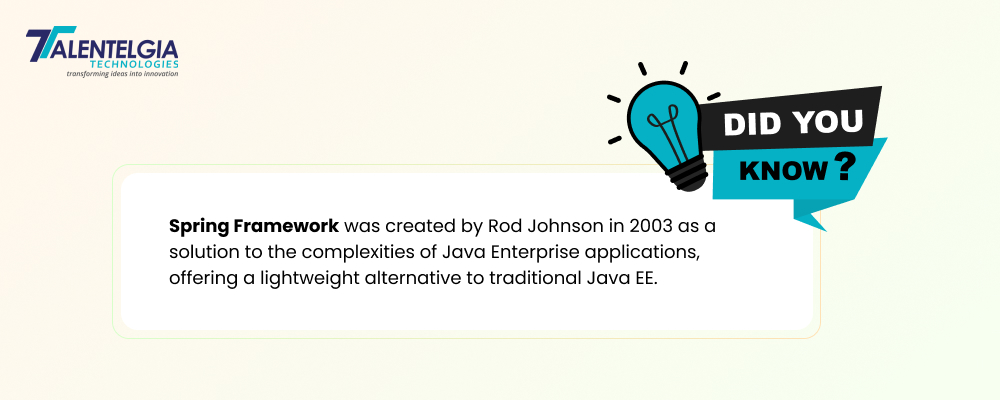
Need for Java Frameworks
Having frameworks in Java is very important, this would eventually help to speed up the development process. Frameworks tend to contain pre-built tools and libraries that are responsible for handling routine activities, while you might concern yourself with building the main features of your apps. It also would mean that it takes care of all the security-related issues, scalability, and dealing with databases, which keeps your code neat, maintainable, and much quicker to write. A framework allows you to build robust, scalable, secure applications much faster and is thus one of the key tools of the modern Java developer.
Java frameworks are crucial to meet various needs which include:
- Simplifying: Java Frameworks handle lots of repetitive tasks, freeing the developer to work on the core application logic.
- Speed: Development gets faster as frameworks have lots of built-in libraries and tools for speeding up the development process.
- Scaling: Most of the frameworks allow the scaling of applications right out of the box.
- Security: Most of the Java frameworks are full of default security features that protect your apps from the most common vulnerabilities.
10 Best Java Frameworks to Explore
Following are some of the best Java frameworks that you must learn about, which include:
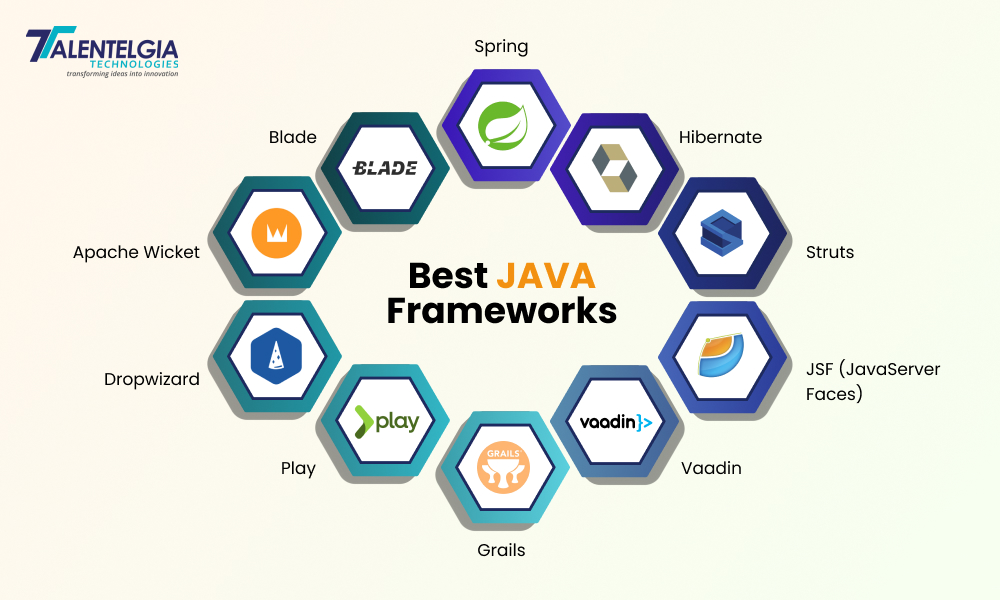
1. Spring
Spring is a versatile framework, best fitted for enterprise-oriented applications. Due to the flexibility and enormous set of features, it provides possibilities for developers to construct robust and scalable solutions with ease. From dependency injection down to integrated security, Spring provides tools that enhance the development speed; hence, a first choice in cases where efficiency and reliability are in need for projects of high complexity.
Key Features of Spring
- Supports dependency injection for simple object management.
- It allows aspect-oriented programming
- A very powerful security and data access tool
- Integrates with several other Java-based frameworks and libraries
Advantages of Spring
- Extremely flexible and modular.
- Great for large-scale applications.
- Great community support and documentation.
Disadvantages of Spring
- It may be a little overwhelming for a beginner due to the great amount of features within.
- Takes time to learn.
2. Hibernate
Hibernate is an ORM framework that, by mapping Java objects to database tables, makes the lives of developers dealing with databases a lot easier. In this respect, intuitively working with data in a more object-oriented manner does not require writing long, confusing SQL queries. Using common tasks like retrieval, maintenance, and updating of data, Hibernate makes the whole development process in general easier and less error-prone.
Key Features of Hibernate
- May automatically generate and handle the creation of the database table.
- It encapsulates heavyweight SQL queries through object-oriented code.
- Supports multiple databases.
Advantages of Hibernate
- Less boilerplate SQL code.
- Works with most relational databases.
- Performance increases via caching.
Disdvantages of Hibernate
- Slows down with larger databases.
- Requires some decent background in using a database.
3. Struts
Apache Struts is a web application development framework based on the Model-View-Controller, or in short, MVC architectural design pattern, where an application is divided into three sets of components. The Model represents the data, the View is responsible for presenting the user interface, and the Controller takes care of the actions based on the user inputs.
In Struts, these components are kept in their places to establish a well-structured and maintainable development life cycle. This makes it easier to develop complex projects, updates are smoother, and the scalability issue also becomes easy; hence, Struts is preferred when developing big enterprise-level applications.
Key Features of Struts
- Following the MVC architecture, it neatly structures the code.
- It’s very easy to integrate third-party libraries.
- Helpful pre-existing actions are provided in this framework for web development.
Advantages of Struts
- Keep your code clean and neat.
- Suitable for big projects.
- It is plug-in enabled.
Disadvantages of Struts
- It is fresher when compared with other newer frameworks.
- It’s a pretty steep learning curve for beginners.
4. JSF (JavaServer Faces)
JavaServer Faces is a component-oriented framework for web development that simply represents user interfaces in your Java web application. By decoupling the UI from an application’s business logic, JSF allows developers to create and maintain each piece independently.
Such separation contributes to smoothing out the development process: this would easily build, maintain, and update complex web applications. JSF also provides several reusable UI components that reduce tedious work in writing similar code again and again. This saves time along with boosting efficiency.
Key Features of JSF
- Rich set of UI components.
- Inherent support for event handling and state management.
- Simplifies the creation of reusable components.
Advantages of JSF
- Tight integration with IDEs for rapid development.
- Alleviates the pains of developing the reusability of web page components.
- Well-suited for large enterprise applications.
Disadvantages of JSF
- Tends to be a bit sluggish due to its heaviness on components.
- Additional setup than most other available frameworks.
5. Vaadin
Vaadin is a powerful framework that makes developing easier with its helper tools, ready-to-use components, and clean architecture to build modern, single-page web applications in Java. It makes the development process easier by allowing developers to easily build interactive, user-friendly, and responsive web interfaces. This frees you from the front-end complexities, allowing you to concentrate on the core logic of your application while it takes care of everything else, thus providing a speedier and even more efficient way of developing applications.
Key Features of Vaadin
- Offers ready-to-use UI components in the largest number.
- It does have real-time communication with a server.
- Supports server-side as well as client-side development.
Advantages of Vaadin
- Reduces complexities for front-end when doing Java-based development.
- Has very active community support and great documentation.
- Best Fit for Complex User Interfaces
Disdvantages of Vaadin
- Not as flexible as other systems.
- Can be slow for very large applications.
6. Grails
Grails is a web framework that uses the Groovy language, extending the robust Spring framework. This allows for rapid application development through a set of built-in functions and conventions. Some of these capabilities simplify coding that is required, reduce boilerplate code, and create much-improved efficiency that allows developers to construct and deploy applications faster and with greater value. Grails integration with Spring further provides scalability, maintainability, and adherence to best practices of the applications.
Key Features of Grails
- Convention-over-configuration approach.
- Out-of-the-box ORM through GORM.
- Effortless integration with Java libraries.
Advantages of Grails
- Ease of Rapid Application development.
- Very easy to learn for developers who have experience in Java and Groovy.
- Great community support.
Disadvantages of Grails
- Limited to Groovy, which might not be ideal for every developer.
- Not as widely used as some other frameworks.
7. Play
Play is a lightweight, stateless framework that enables rapid development and deployment of high-speed, high-performance web applications. It is perfectly designed to be simple and efficient and can make rapid development of scalable web applications easy and time-saving.
At the minimum level of complexity and with strong out-of-the-box tools at your fingertips, Play supports you in crafting responsive, robust web applications with the least overhead for maximum performance and a fast development cycle.
Features of Play
- Asynchronous programming for high performance.
- Built-in support for testing and scalability.
- Reactive architecture.
Advantages of Play
- High-performance applications and scalability.
- Smooth integrations with modern technologies.
- Ideal for RESTful web service.
Disadvantages of Play
- Very steep learning curve for beginners.
- Less popularity means fewer resources and tutorials available.
8. Dropwizard
Dropwizard is a light, Java framework intended to be used for building RESTful web applications with minimal wasting of time. It relieves development by bringing in the essential tools and libraries that make the creation and maintenance of APIs straightforward.
With Dropwizard, you will have your project up and running in no time, save yourself from the headache of configuration, and be assured of delivering efficient and robust APIs. Its efficiency and simplicity make it one of the favorite choices of developers who want to build high-performance web applications with very minimal overhead.
Features of Dropwizard
- Preconfigured libraries for Security, Logging, and so on.
- Focuses on simplicity and rapid development.
- Supports microservices architecture.
Advantages of Dropwizard
- Easy to use for small to middle-sized applications.
- Good to go for microservices as well as APIs.
- Minimum configuration.
Disadvantages of Dropwizard
- Not that flexible due to its focus on simplicity.
- Not suitable for large applications.
9. Apache Wicket
Apache Wicket is a lightweight, component-oriented web application framework intended to simplify and make the development process easier. Wicket allows developers to build web applications by assembling reusable UI components, thus making things easier.
In Wicket, the ease of reuse at the component level ensures less code manageability, hence less complexity and higher productivity while developing and maintaining the code. This makes it far easier to develop and maintain web applications; therefore, Wicket is one of the most useful frameworks when it comes to dynamic web solution implementation.
Key Features of Apache Wicket
- Page pages are wired using Java code.
- Simplifies handling of state.
- It allows reusable components.
Advantages of Apache Wicket
- Very easy to learn and use.
- Boosts clean code along with separation of concerns.
- Suitable for small to medium-sized web applications.
Disadvantages of Apache Wicket
- Not suitable for complex, big enterprise applications.
- Limited community support.
10. Blade
Blade is a lightweight, modern Java web framework that is designed for productivity and high efficiency. It lets developers create rapid and efficient web applications with ease. The prime focus on simplicity and efficiency on the part of Blade ensures applications run effortlessly fast and responsively, ensuring users have an optimal experience. Its design minimizes unnecessary overhead and makes development quicker and more straightforward, thereby helping develop quality applications without the typical headache.
Key Features of Blade
- Simple and fast setup with at least configuration.
- Restful routing.
Advantages of Blade
- Very easy to learn and use.
- Great for small applications.
- Fast in performance due to its minimalistic nature.
Disadvantages of Blade
- Limited feature set as compared to bigger frameworks.
- Not suitable for enterprise-level applications.
Also Read: Top Ten Backend Frameworks
Conclusion
We can say that Java frameworks are about modern development based on tools and structures that ease coding and improve performance, offering security features. Businesses often turn to outsource Java development to build robust, scalable, and maintainable applications efficiently Among the best Java frameworks, Spring, Hibernate, and Struts enjoy leading positions due to their flexibility, scalability, and strong features. Whether you build a very simple application or a large system, you should surely try these frameworks.


 Healthcare App Development Services
Healthcare App Development Services
 Real Estate Web Development Services
Real Estate Web Development Services
 E-Commerce App Development Services
E-Commerce App Development Services E-Commerce Web Development Services
E-Commerce Web Development Services Blockchain E-commerce Development Company
Blockchain E-commerce Development Company
 Fintech App Development Services
Fintech App Development Services Fintech Web Development
Fintech Web Development Blockchain Fintech Development Company
Blockchain Fintech Development Company
 E-Learning App Development Services
E-Learning App Development Services
 Restaurant App Development Company
Restaurant App Development Company
 Mobile Game Development Company
Mobile Game Development Company
 Travel App Development Company
Travel App Development Company
 Automotive Web Design
Automotive Web Design
 AI Traffic Management System
AI Traffic Management System
 AI Inventory Management Software
AI Inventory Management Software
 AI Software Development
AI Software Development  AI Development Company
AI Development Company  AI App Development Services
AI App Development Services  ChatGPT integration services
ChatGPT integration services  AI Integration Services
AI Integration Services  Generative AI Development Services
Generative AI Development Services  Natural Language Processing Company
Natural Language Processing Company Machine Learning Development
Machine Learning Development  Machine learning consulting services
Machine learning consulting services  Blockchain Development
Blockchain Development  Blockchain Software Development
Blockchain Software Development  Smart Contract Development Company
Smart Contract Development Company  NFT Marketplace Development Services
NFT Marketplace Development Services  Asset Tokenization Company
Asset Tokenization Company DeFi Wallet Development Company
DeFi Wallet Development Company Mobile App Development
Mobile App Development  IOS App Development
IOS App Development  Android App Development
Android App Development  Cross-Platform App Development
Cross-Platform App Development  Augmented Reality (AR) App Development
Augmented Reality (AR) App Development  Virtual Reality (VR) App Development
Virtual Reality (VR) App Development  Web App Development
Web App Development  SaaS App Development
SaaS App Development Flutter
Flutter  React Native
React Native  Swift (IOS)
Swift (IOS)  Kotlin (Android)
Kotlin (Android)  Mean Stack Development
Mean Stack Development  AngularJS Development
AngularJS Development  MongoDB Development
MongoDB Development  Nodejs Development
Nodejs Development  Database Development
Database Development Ruby on Rails Development
Ruby on Rails Development Expressjs Development
Expressjs Development  Full Stack Development
Full Stack Development  Web Development Services
Web Development Services  Laravel Development
Laravel Development  LAMP Development
LAMP Development  Custom PHP Development
Custom PHP Development  .Net Development
.Net Development  User Experience Design Services
User Experience Design Services  User Interface Design Services
User Interface Design Services  Automated Testing
Automated Testing  Manual Testing
Manual Testing  Digital Marketing Services
Digital Marketing Services 
 Ride-Sharing And Taxi Services
Ride-Sharing And Taxi Services Food Delivery Services
Food Delivery Services Grocery Delivery Services
Grocery Delivery Services Transportation And Logistics
Transportation And Logistics Car Wash App
Car Wash App Home Services App
Home Services App ERP Development Services
ERP Development Services CMS Development Services
CMS Development Services LMS Development
LMS Development CRM Development
CRM Development DevOps Development Services
DevOps Development Services AI Business Solutions
AI Business Solutions AI Cloud Solutions
AI Cloud Solutions AI Chatbot Development
AI Chatbot Development API Development
API Development Blockchain Product Development
Blockchain Product Development Cryptocurrency Wallet Development
Cryptocurrency Wallet Development About Talentelgia
About Talentelgia  Our Team
Our Team  Our Culture
Our Culture 
 Healthcare App Development Services
Healthcare App Development Services Real Estate Web Development Services
Real Estate Web Development Services E-Commerce App Development Services
E-Commerce App Development Services E-Commerce Web Development Services
E-Commerce Web Development Services Blockchain E-commerce
Development Company
Blockchain E-commerce
Development Company Fintech App Development Services
Fintech App Development Services Finance Web Development
Finance Web Development Blockchain Fintech
Development Company
Blockchain Fintech
Development Company E-Learning App Development Services
E-Learning App Development Services Restaurant App Development Company
Restaurant App Development Company Mobile Game Development Company
Mobile Game Development Company Travel App Development Company
Travel App Development Company Automotive Web Design
Automotive Web Design AI Traffic Management System
AI Traffic Management System AI Inventory Management Software
AI Inventory Management Software AI Software Development
AI Software Development AI Development Company
AI Development Company ChatGPT integration services
ChatGPT integration services AI Integration Services
AI Integration Services Machine Learning Development
Machine Learning Development Machine learning consulting services
Machine learning consulting services Blockchain Development
Blockchain Development Blockchain Software Development
Blockchain Software Development Smart contract development company
Smart contract development company NFT marketplace development services
NFT marketplace development services IOS App Development
IOS App Development Android App Development
Android App Development Cross-Platform App Development
Cross-Platform App Development Augmented Reality (AR) App
Development
Augmented Reality (AR) App
Development Virtual Reality (VR) App Development
Virtual Reality (VR) App Development Web App Development
Web App Development Flutter
Flutter React
Native
React
Native Swift
(IOS)
Swift
(IOS) Kotlin (Android)
Kotlin (Android) MEAN Stack Development
MEAN Stack Development AngularJS Development
AngularJS Development MongoDB Development
MongoDB Development Nodejs Development
Nodejs Development Database development services
Database development services Ruby on Rails Development services
Ruby on Rails Development services Expressjs Development
Expressjs Development Full Stack Development
Full Stack Development Web Development Services
Web Development Services Laravel Development
Laravel Development LAMP
Development
LAMP
Development Custom PHP Development
Custom PHP Development User Experience Design Services
User Experience Design Services User Interface Design Services
User Interface Design Services Automated Testing
Automated Testing Manual
Testing
Manual
Testing About Talentelgia
About Talentelgia Our Team
Our Team Our Culture
Our Culture
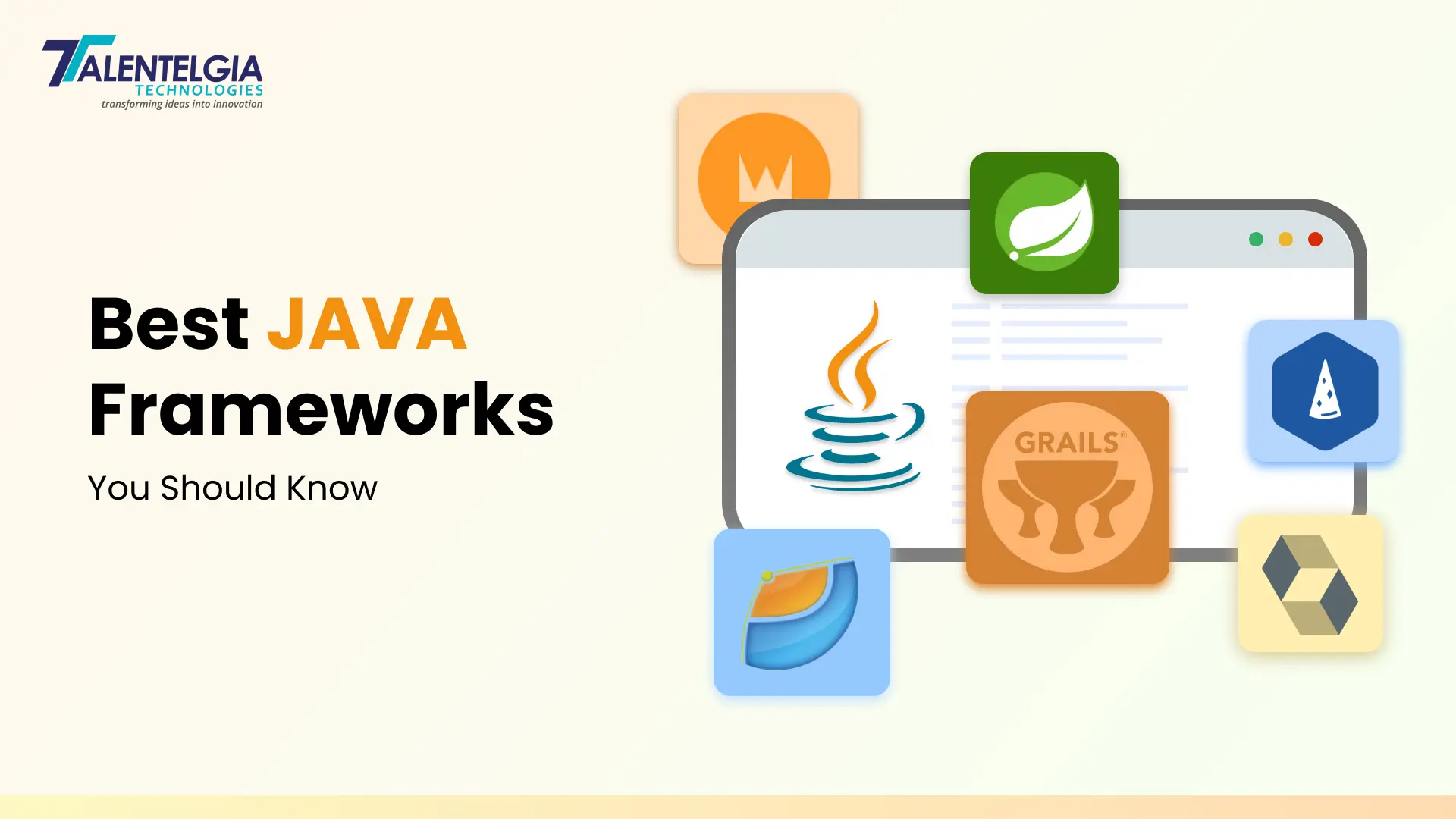



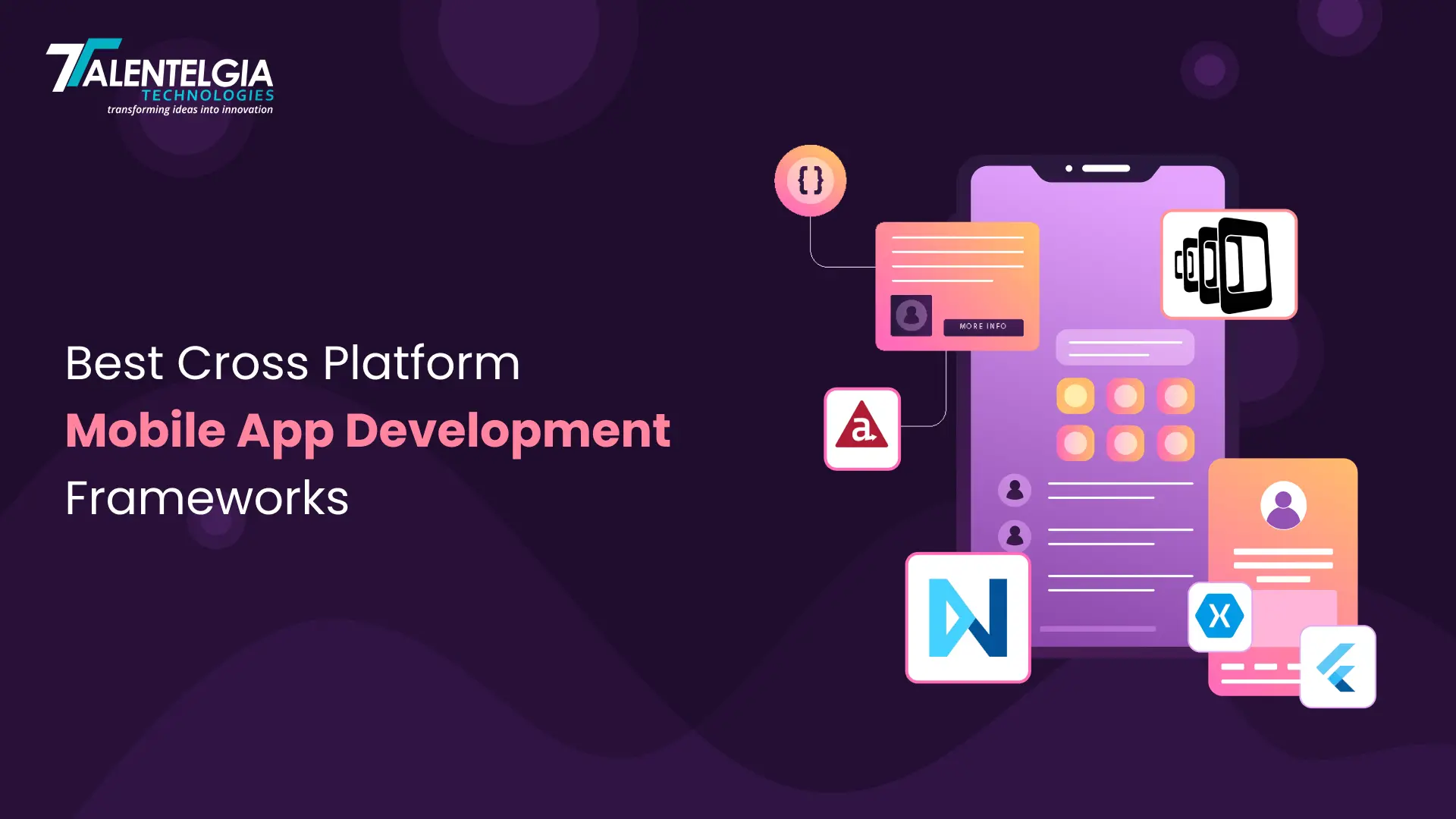
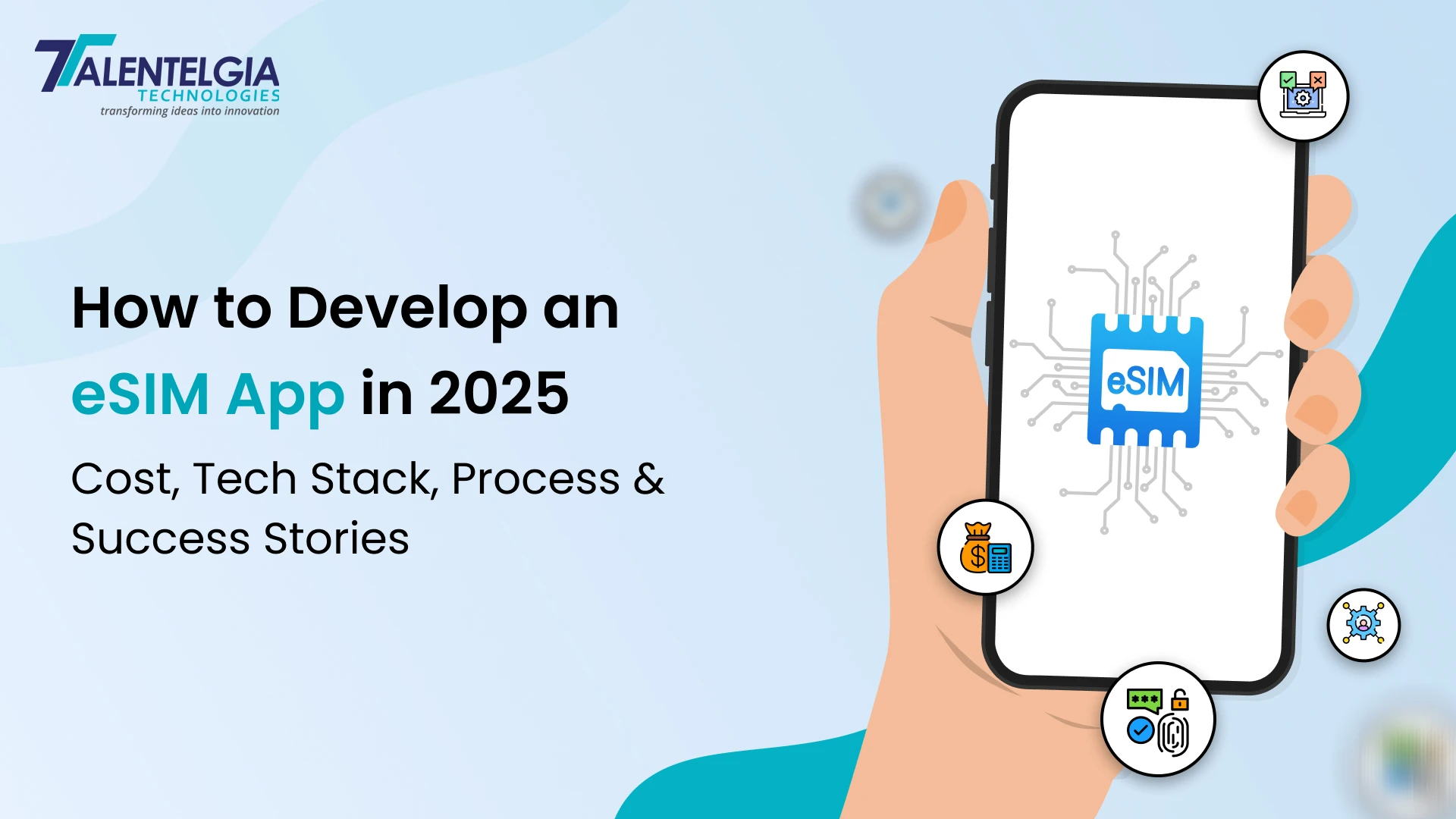










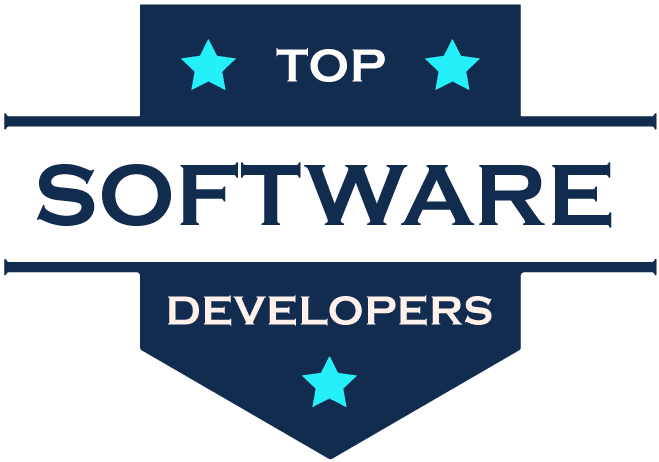
 Write us on:
Write us on:  Business queries:
Business queries:  HR:
HR: 





